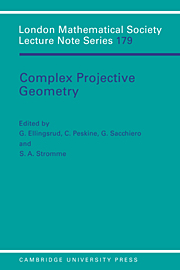Book contents
- Frontmatter
- Contents
- INTRODUCTION
- PROJECTIVE VARIETIES
- VECTOR BUNDLES AND SPECIAL PROJECTIVE EMBEDDINGS
- LIST OF PARTICIPANTS
- Speciality one rational surfaces in P4
- Bounding sections of bundles on curves
- The smooth surfaces of degree 9 in P4
- Compactifying the space of elliptic quartic curves
- Threefolds of degree 11 in P5
- Complete extensions and their map to moduli space
- On the Betti numbers of the moduli space of stable bundles of rank two on a curve
- Gaussian maps for certain families of canonical curves
- Geometry of the Horrocks bundle on P3
- Stability and restrictions of Picard bundles, with an application to the normal bundles of elliptic curves
- Sections planes et majoration du genre des courbes gauches
- A tribute to Corrado Segre
- Un aperçu des travaux mathématiques de G.H. Halphen (1844–1889)
- The source double-point cycle of a finite map of codimension one
- Fibré déterminant et courbes de saut sur les surfaces algébriques
- Courbes minimales dans les classes de biliaison
- Fano 3-folds
- Polarized K3 surfaces of genus 18 and 20
- Protective compactifications of complex afflne varieties
- On generalized Laudal's lemma
- Sur la stabilité des sous-variétés lagrangiennes des variétés symplectiques holomorphes
- Introduction to Gaussian maps on an algebraic curve
- Some examples of obstructed curves in P3
The source double-point cycle of a finite map of codimension one
Published online by Cambridge University Press: 06 July 2010
- Frontmatter
- Contents
- INTRODUCTION
- PROJECTIVE VARIETIES
- VECTOR BUNDLES AND SPECIAL PROJECTIVE EMBEDDINGS
- LIST OF PARTICIPANTS
- Speciality one rational surfaces in P4
- Bounding sections of bundles on curves
- The smooth surfaces of degree 9 in P4
- Compactifying the space of elliptic quartic curves
- Threefolds of degree 11 in P5
- Complete extensions and their map to moduli space
- On the Betti numbers of the moduli space of stable bundles of rank two on a curve
- Gaussian maps for certain families of canonical curves
- Geometry of the Horrocks bundle on P3
- Stability and restrictions of Picard bundles, with an application to the normal bundles of elliptic curves
- Sections planes et majoration du genre des courbes gauches
- A tribute to Corrado Segre
- Un aperçu des travaux mathématiques de G.H. Halphen (1844–1889)
- The source double-point cycle of a finite map of codimension one
- Fibré déterminant et courbes de saut sur les surfaces algébriques
- Courbes minimales dans les classes de biliaison
- Fano 3-folds
- Polarized K3 surfaces of genus 18 and 20
- Protective compactifications of complex afflne varieties
- On generalized Laudal's lemma
- Sur la stabilité des sous-variétés lagrangiennes des variétés symplectiques holomorphes
- Introduction to Gaussian maps on an algebraic curve
- Some examples of obstructed curves in P3
Summary
Abstract. Let X, Y be smooth varieties of dimensions n, n + 1 over an algebraically closed field, and f:X → Y a finite map, birational onto its image Z. The source double-point set supports two natural positive cycles: (1) the fundamental cycle of the divisor M2 denned by the conductor of X/Z, and (2) the direct image of the fundamental cycle of the residual scheme X2 of the diagonal in the product X XyX. Over thirteen years ago, it was conjectured that the two cycles are equal if the characteristic is 0 or f is “appropriately generic.” That conjecture will be established in a more general form.
Introduction
Let X and Y be smooth varieties over an algebraically closed field, and assume that dim Y − dim X = 1. Let f:X → Y be a finite map that is birational onto its image Z. For example, X might be a projective variety, and f a general central projection onto a hypersurface Z in Y := Pn+1. Consider the source double-point scheme M2 of f. By definition, M2 is the effective divisor whose ideal is the conductor Cx of X/Z. Its underlying set consists of the points x of X whose fiber f−1f(x) is a scheme of length at least 2. Consider also the residual scheme X2 of the fiber product X xyX with respect to the diagonal. By definition, X2 := P(I(Δ)) where I(Δ) is the ideal of the diagonal. Consider finally the map f1:X2 → X induced by the second projection.
Information
- Type
- Chapter
- Information
- Complex Projective GeometrySelected Papers, pp. 199 - 212Publisher: Cambridge University PressPrint publication year: 1992
Accessibility standard: Unknown
Why this information is here
This section outlines the accessibility features of this content - including support for screen readers, full keyboard navigation and high-contrast display options. This may not be relevant for you.Accessibility Information
- 6
- Cited by
